|
|
March 20th, 2014
This new tool trims cases quickly, with precision control over case length via a micrometer-type dial. The folks at ACT Tactical have developed an easy-to-use compact case trimmer called the TRIM-IT. Crafted from 6061-T6 aluminum, this sturdy case trimmer comes with a 100% lifetime guarantee. The $97.50 TRIM-IT features a micrometer that’s built into the unit itself. Caliber-specific inserts (called “Caliber Dies”) index off the case shoulder.

The TRIM-IT can work with any hand-drill or drill press. Once you get the hang of it, you can trim a case in 7-8 seconds — that gives you a production rate of 400+ cases per hour. The TRIM-IT delivers repeatable precision to plus/minus one-thousandth. This unit also holds its cut-length setting, unlike some other trimmers which require frequent adjustment.

The basic unit ships with two caliber dies, for .223 and .308. Other listed caliber dies include 6.8 SPC, .300 BLK, .30-06, 30-30 Win, 300 Win Mag, 7MM REM, 7.62x54R, and 8MM Mauser. Other cartridge types can be custom-ordered from EZTrimit.com. To change dies, simply loosen the set screw on the TRIM-IT, take the caliber die out, add another one, and tighten the screw — quick and easy.
The built-in micrometer is great. The handy dial gives you a positive, repeatable length setting quickly — no fiddling with locking rings or spacers. Once you get the ring set properly, the cut lengths are consistent from the first case to the last. Expect your case OAL spread to be about +/- .001″ (starting with full-length-sized cases with uniform rim to shoulder lengths). For more information, email sales [at] eztrimit.com or call (562) 602-0080. You can see how the Trim-It device works in the video below.
Video Shows Trim-it Set-Up and Operation
Share the post "Trim-It Case Trimmer Features Micrometer Cut-Length Control"
March 2nd, 2014
What is “Overbore”? That’s a question rifle shooters can debate to no end. This article from our archives proposes one way to identify “overbore cartridges”. We think the approach outlined here is quite useful, but we know that there are other ways to define cartridges with “overbore” properties. Whenever we run this article, it stimulates a healthy debate among our readers — and that is probably a good thing.
Forum Member John L. has been intrigued by the question of “overbore” cartridges. People generally agree that overbore designs can be “barrel burners”, but is there a way to predict barrel life based on how radically a case is “overbore”? John notes that there is no generally accepted definition of “overbore”. Based on analyses of a wide variety of cartridges, John hoped to create a comparative index to determine whether a cartridge is more or less “overbore”. This, in turn, might help us predict barrel life and maybe even predict the cartridge’s accuracy potential.
John tells us: “I have read countless discussions about overbore cartridges for years. There seemed to be some widely accepted, general rules of thumb as to what makes a case ‘overbore’. In the simplest terms, a very big case pushing a relatively small diameter bullet is acknowledged as the classic overbore design. But it’s not just large powder capacity that creates an overbore situation — it is the relationship between powder capacity and barrel bore diameter. Looking at those two factors, we can express the ‘Overbore Index’ as a mathematical formula — the case capacity in grains of water divided by the area (in square inches) of the bore cross-section. This gives us an Index which lets us compare various cartridge designs.”


OVERBORE INDEX Chart
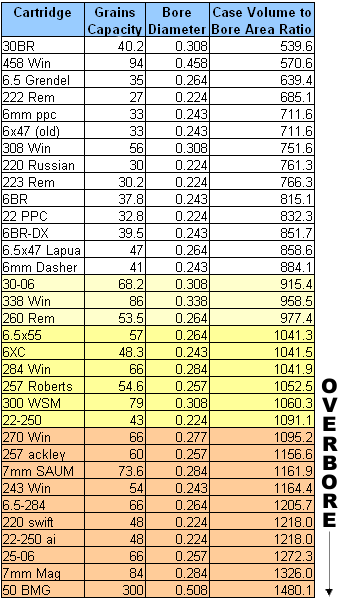
So what do these numbers mean? John says: “My own conclusion from much reading and analysis is that cartridges with case volume to bore area ratio less than 900 are most likely easy on barrels and those greater than 1000 are hard on barrels.” John acknowledges, however, that these numbers are just for comparison purposes. One can’t simply use the Index number, by itself, to predict barrel life. For example, one cannot conclude that a 600 Index number cartridge will necessarily give twice the barrel life of a 1200 Index cartridge. However, John says, a lower index number “seems to be a good predictor of barrel life”.
John’s system, while not perfect, does give us a benchmark to compare various cartridge designs. If, for example, you’re trying to decide between a 6.5-284 and a 260 Remington, it makes sense to compare the “Overbore Index” number for both cartridges. Then, of course, you have to consider other factors such as powder type, pressure, velocity, bullet weight, and barrel hardness.
Overbore Cases and Accuracy
Barrel life may not be the only thing predicted by the ratio of powder capacity to bore cross-section area. John thinks that if we look at our most accurate cartridges, such as the 6 PPC, and 30 BR, there’s some indication that lower Index numbers are associated with greater inherent accuracy. This is only a theory. John notes: “While I do not have the facilities to validate the hypothesis that the case capacity to bore area ratio is a good predictor of accuracy — along with other well-known factors — it seems to be one important factor.”
Share the post "Defining “Overbore” Cartridges via Comparative Index"
February 15th, 2014
 Nosler has introduced a new 6.5mm (.264 caliber) hunting cartridge, the 26 Nosler. Nosler will initially offer 26 Nosler cartridge brass, and then, eventually, 26 Nosler loaded ammunition. Nosler has introduced a new 6.5mm (.264 caliber) hunting cartridge, the 26 Nosler. Nosler will initially offer 26 Nosler cartridge brass, and then, eventually, 26 Nosler loaded ammunition.
This new cartridge is designed to be a speedy, flat-shooting hunting cartridge, with performance exceeding a 6.5-284. This is possible because the 26 Nosler is a big, long cartridge with plenty of “boiler room”. Length from base to neck/shoulder junction is 2.33″ for the 26 Nosler, compared to 1.91″ for the 6.5-284 (and 2.04″ for a 7mm Rem Magnum). The 26 Nosler has a 35° shoulder angle and a magnum-size 0.534″ outside rim diameter.
The 26 Nosler cartridge can drive the Nosler 129 grain, AccuBond® LR bullet at 3400 fps. Zeroed at 350 yards, the 26 Nosler has a Point Blank Range of 0-415 yards. Loaded with the 129gr Accubond, the 26 Nosler retains as much velocity at 400 yards as a .260 Rem produces at the muzzle. This makes the 26 Nosler a “quintessential deer, antelope and long-range” cartridge according to company CEO/President Bob Nosler.
Nosler has just released the SAMMI print for this cartridge. CLICK HERE for SAMMI Print PDF.
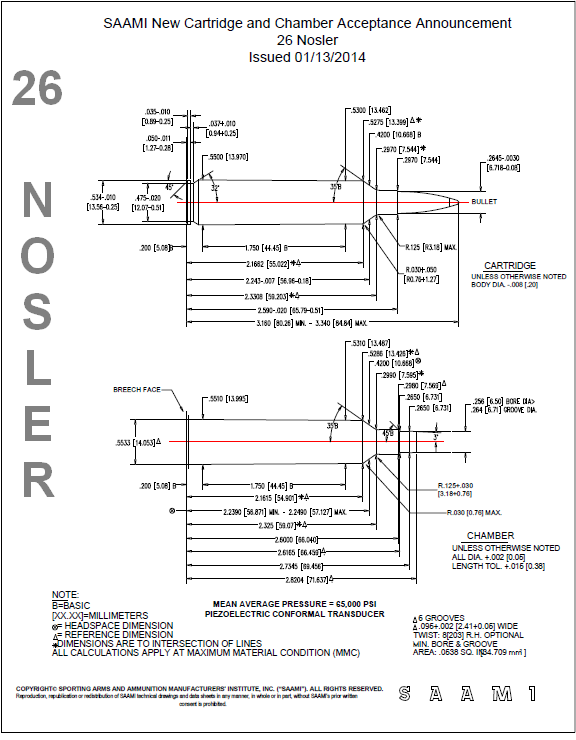 Credit Grant G. for story tip. We welcome reader submissions.
Credit Grant G. for story tip. We welcome reader submissions.
Share the post "Official 26 Nosler SAAMI Drawing Now Available"
December 21st, 2013
 Norma is making a big push to expand its presence in the North American market. As part of this effort, Norma is introducing seven (7) new types of cartridge brass for 2014. We’re pleased to report that Norma-USA will be importing top-quality brass for the 6.5 Grendel, and 6.5 Creedmoor, two popular target cartridges. In addition, for 2014, Norma will offer 7mm RUM, 7mm Blaser Magnum, 300 AAC Blackout (300 BLK), .300 RUM, and the .338 Blaser Mag. The Norma brass we have shot in other chamberings (6 PPC, 6mmBR Norma, 6XC, .243, 7mm RSAUM) has all been excellent, giving good accuracy. Case weights were very consistent and the neck-wall thickness was very uniform, particularly with the PPC and BR brass. The new 300 BLK brass is an important offering for AR shooters. (NOTE: You can also make 300 BLK cases from Norma or Lapua .221 Fireball brass). Norma is making a big push to expand its presence in the North American market. As part of this effort, Norma is introducing seven (7) new types of cartridge brass for 2014. We’re pleased to report that Norma-USA will be importing top-quality brass for the 6.5 Grendel, and 6.5 Creedmoor, two popular target cartridges. In addition, for 2014, Norma will offer 7mm RUM, 7mm Blaser Magnum, 300 AAC Blackout (300 BLK), .300 RUM, and the .338 Blaser Mag. The Norma brass we have shot in other chamberings (6 PPC, 6mmBR Norma, 6XC, .243, 7mm RSAUM) has all been excellent, giving good accuracy. Case weights were very consistent and the neck-wall thickness was very uniform, particularly with the PPC and BR brass. The new 300 BLK brass is an important offering for AR shooters. (NOTE: You can also make 300 BLK cases from Norma or Lapua .221 Fireball brass).
Though the annealing “shadow” may not be as visible as with Lapua brass, the case necks of Norma brass cartridges are indeed annealed near the end of the manufacturing process. This assures more consistent neck tension — something critical to accuracy. Most of the new cartridge brass offerings should be be available at vendors by early April, 2014. You can get Norma brass from Bullets.com, Grafs.com and Midsouth Shooters Supply, as well as many other online vendors.
New Norma-USA Brass Offerings for 2014:
- 6.5 Grendel
- 6.5 Creedmoor
- 7mm RUM
- 7mm Blaser Magnum
|
- 300 AAC Blackout (300 BLK)
- .300 RUM
- .338 Blaser Magnum
|
Product Tip from EdLongrange. We welcome reader submissions.
Share the post "Norma Offers Seven New Types of Cartridge Brass for 2014"
December 19th, 2013
 On his Riflemans’ Journal blog, German Salazar wrote an excellent article about cartridge Case-Head Separation. We strongly recommend that you read this article. German examines the causes of this serious problem and he explains the ways you can inspect your brass to minimize the risk of a case-head separation. As cases get fired multiple times and then resized during reloading, the cases can stretch. Typically, there is a point in the lower section of the case where the case-walls thin out. This is your “danger zone” and you need to watch for tell-tale signs of weakening. On his Riflemans’ Journal blog, German Salazar wrote an excellent article about cartridge Case-Head Separation. We strongly recommend that you read this article. German examines the causes of this serious problem and he explains the ways you can inspect your brass to minimize the risk of a case-head separation. As cases get fired multiple times and then resized during reloading, the cases can stretch. Typically, there is a point in the lower section of the case where the case-walls thin out. This is your “danger zone” and you need to watch for tell-tale signs of weakening.
The photo below shows a case sectioned so that you can see where the case wall becomes thinner near the web. German scribed a little arrow into the soot inside the case pointing to the thinned area. This case hadn’t split yet, but it most likely would do so after one or two more firings.

One great tip offered by German Salazar involves using a bent paper clip to detect potential case wall problems. Slide the paper clip inside your case to check for thin spots. German explains: “This simple little tool (bent paper clip) will let you check the inside of cases before you reload them. The thin spot will be immediately apparent as you run the clip up the inside of the case. If you’re seeing a shiny line on the outside and the clip is really hitting a thin spot inside, it’s time to retire the case. If you do this every time you reload, on at least 15% of your cases, you’ll develop a good feel for what the thin spot feels like and how it gets worse as the case is reloaded more times. And if you’re loading the night before a match and feel pressured for time — don’t skip this step!”

Share the post "Case-Head Separation — Spot Problems Before Things Go Boom…"
December 16th, 2013
California shooter Mark LaFevers has come up with a slick, adjustable fixture that delivers a precise, repeatable inside-neck chamfer every time. He uses a Holland Case Mouth Chamfer Tool with a 14° cutter, but this set-up works equally well with other chamferers with an extended handle. With Mark’s tool jig, the Holland Tool inserts through the top, indexing vertically off a shoulder. A small recess is cut in the center of the wood base for the case head. The tool mount can be raised or lowered with the adjusting bolts on all four corners. Simply slide a trimmed-to-length case in the middle, give the Holland Tool a few spins, and you get a perfect, identical chamfer every time. Now that’s ingenuity! Mark isn’t planning to produce these commercially, but he’s happy if someone wants to copy his jig design.
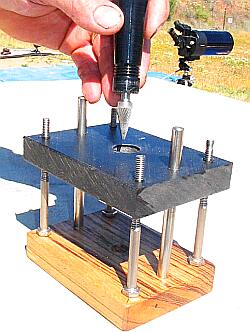 |
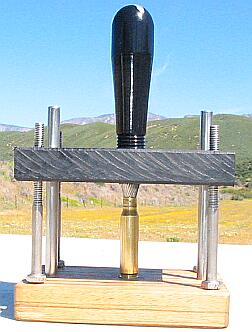 |
NOTE: In the photos above, you see an older version of the tool. Hollands has improved the design of its current 14° Chamfer Tool. The cutting head now has a 3-flute design that provides a smoother, chatterless cut. The head is now made of carbide so it cuts faster and holds its cutting edge longer. This tool is available from Holland’s Shooters Supplies for $32.00 (item CMCT-CAR).

Share the post "Precision Jig for Neck Chamfer Tool"
December 14th, 2013
Lapua just dropped a bombshell — multiple bombshells, in fact. Lapua just announced that it will be producing .221 Fireball brass and .50 BMG brass starting early 2014. This will be the first truly match-grade brass ever offered for the .221 Fireball. That’s great news for varminters, who can use Lapua’s new .221 Fireball brass “as is” or neck it down to .20 Vartarg or 17 Fireball. Tactical shooters can also use the .221 Fireball brass to make the .300 Whisper and 300 Blackout sub-sonic cartridges. At the other end of the spectrum, ultra-long-range shooters now have a new ultra-premium brass source for the mighty .50 BMG. This is potentially a “game-changer” for fifty-cal shooters who have had to “make do” with military surplus brass for the most part. Lapua says the new brass, both .50 BMG and .221 Fireball, should be in the USA by early April, 2014. Sorry, no pricing info is yet available.
Here is the Lapua Product Announcement for .221 Fireball and .50 BMG Brass:

New 180-Grain and 150-Grain 7mm Scenar-L Bullets
The other big news from Lapua is the release of two new 7mm (.284 caliber) Scenar-L target bullets. Recognizing the popularity of 7mm cartridges among F-Class Open Division shooters, Lapua will offer a high-BC, 180-grain bullet. As part of the “L” series, this new 180-grainer bullet should exhibit extreme consistency in base-to-ogive measurements and bullet weight. We expect this new 180gr projectile to be extremely accurate in the .284 Winchester, .284 Shehane, 7mm WSM, and 7mm RSAUM — popular chamberings for F-Class and long-range benchrest shooters. No BC information has been released yet, but we expect the BC number to be quite high, giving this bullet great wind-bucking capability. In addition to the new 180gr 7mm Scenar-L, Lapua will offer a new 150gr 7mm bullet. This is optimized for medium range competition in Silhouette and Across-the-Course competition. It should offer great accuracy, but with less felt recoil than its 180-grain bigger brother.

Share the post "Lapua 2014 News — .221 Fireball and .50 BMG Brass, 7mm Bullets"
December 2nd, 2013
 When neck-turning cases, it’s a good idea to extend the cut slightly below the neck-shoulder junction. This helps keep neck tension more uniform after repeated firings, by preventing a build-up of brass where the neck meets the shoulder. One of our Forum members, Craig from Ireland, a self-declared “neck-turning novice”, was having some problems turning brass for his 20 Tactical cases. He was correctly attempting to continue the cut slightly past the neck-shoulder junction, but he was concerned that brass was being removed too far down the shoulder. When neck-turning cases, it’s a good idea to extend the cut slightly below the neck-shoulder junction. This helps keep neck tension more uniform after repeated firings, by preventing a build-up of brass where the neck meets the shoulder. One of our Forum members, Craig from Ireland, a self-declared “neck-turning novice”, was having some problems turning brass for his 20 Tactical cases. He was correctly attempting to continue the cut slightly past the neck-shoulder junction, but he was concerned that brass was being removed too far down the shoulder.
Craig writes: “Everywhere I have read about neck turning, [it says] you need to cut slightly into the neck/shoulder junction to stop doughnutting. I completely understand this but I cant seem to get my neck-turning tool set-up to just touch the neck/shoulder junction. It either just doesn’t touch [the shoulder] or cuts nearly the whole shoulder and that just looks very messy. No matter how I adjust the mandrel to set how far down the neck it cuts, it either doesn’t touch it or it cuts far too much. I think it may relate to the bevel on the cutter in my neck-turning tool…”

Looking at Craig’s pictures, we’d agree that he didn’t need to cut so far down into the shoulder. There is a simple solution for this situation. Craig is using a neck-turning tool with a rather shallow cutter bevel angle. This 20-degree angle is set up as “universal geometry” that will work with any shoulder angle. Unfortunately, as you work the cutter down the neck, a shallow angled-cutter tip such as this will remove brass fairly far down. You only want to extend the cut about 1/32 of an inch past the neck-shoulder junction. This is enough to eliminate brass build-up at the base of the neck that can cause doughnuts to form.

The answer here is simply to use a cutter tip with a wider angle — 30 to 40 degrees. The cutter for the K&M neck-turning tool (above) has a shorter bevel that better matches a 30° shoulder. There is also a 40° tip available. PMA Tool and 21st Century Shooting also offer carbide cutters with a variety of bevel angles to match your case shoulder angle*. WalkerTexasRanger reports: “I went to a 40-degree cutter head just to address this same issue, and I have been much happier with the results. The 40-degree heads are available from Sinclair Int’l for $13 or so.” Forum Member CBonner concurs: “I had the same problem with my 7WSM… The 40-degree cutter was the answer.” Below is Sinclair’s 40° cutter for its NT-1000, NT-1500, and NT-4000 neck-turning tools. Item NT-3140, it sells for $12.95. There is also a 40° cutter for the NT-3000 tool, item NT-3340 ($13.95).
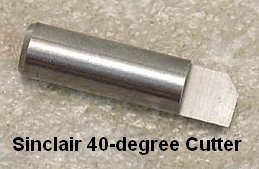
Al Nyhus has another clever solution: “The best way I’ve found to get around this problem is to get an extra shell holder and face it off .020-.025 and then run the cases into the sizing die. This will push the shoulder back .020-.025. Then you neck turn down to the ‘new’ neck/shoulder junction and simply stop there. Fireforming the cases by seating the bullets hard into the lands will blow the shoulder forward and the extra neck length you turned by having the shoulder set back will now be blended perfectly into the shoulder. The results are a case that perfectly fits the chamber and zero donuts.”
* 21st Century sells carbide cutters in: 15, 20, 21.5, 23, 25, 28, 30, 35, 40, and 46 degrees. PMA Tool sells carbide cutters in: 17.5, 20, 23, 25, 28, 30, 35, and 40 degrees.
Share the post "Tool Tip: Optimize Your Cutter Angle for Improved Neck-Turning"
November 12th, 2013
 Hornady plans to start producing .50 BMG ‘Match Grade’ Cartridge Brass. MSRP is $131.99 for twenty (20) cases (Item #8772). Hornady claims the new brass will have very uniform case wall thickness, and very consistent case weight and internal capacity. Hornady has not stated when its .50 BMG brass will start shipping. When the Hornady .50 BMG brass (Item #8772) does hit the market, we expect it will be in high demand. Our friends at the Fifty Caliber Shooters Association (FCSA) tell us that it is “getting harder and harder to get your hands on good .50 Cal brass these days.” Hornady plans to start producing .50 BMG ‘Match Grade’ Cartridge Brass. MSRP is $131.99 for twenty (20) cases (Item #8772). Hornady claims the new brass will have very uniform case wall thickness, and very consistent case weight and internal capacity. Hornady has not stated when its .50 BMG brass will start shipping. When the Hornady .50 BMG brass (Item #8772) does hit the market, we expect it will be in high demand. Our friends at the Fifty Caliber Shooters Association (FCSA) tell us that it is “getting harder and harder to get your hands on good .50 Cal brass these days.”

Grafs.com lists the new Hornady .50 BMG brass in its catalog at $101.99 for 20 cases, but inventory (Item HRN8772) is not yet in stock. CLICK HERE to check for updates.
Product tip from EdLongrange. We welcome reader submissions.
Share the post "Hornady Announces ‘Match Grade’ .50 BMG Brass — ETA Unknown"
November 7th, 2013
Reloaders Rejoice! There’s a new source for bullets, brass, powder, and primers, as well as loaded ammunition. The all-new Bullets.com website offers all these products, plus reloading tools and dies, barrels, gun stocks, scopes, rings, shooting rests, range bags and much more. Primers, you need primers you say? Yes, Bullets.com currently has some types of CCI, Federal, and Remington primers in stock, including the hard-to-find CCI 450 small rifle magnum primers.
You definitely want to include Bullets.com among the vendors you visit when you need components and gun hardware. The new Bullets.com webstore will carry 8,000+ shooting-related products from over 50 top brands such as Lapua, Norma, Federal, CCI, Berger, Sierra, Berry’s, Bald Eagle, Bushnell, Hodgdon, Alliant, Nightforce, Kowa, Vortex, Winchester, MTM, Magpul and many more! Check out the website at www.bullets.com or call 1-800-235-0272 to get a free 60-page color catalog.
POWDERS IN STOCK — Among the popular powders in stock at Bullets.com today are:
- Hodgdon H4895, Hodgdon H4350, Hodgdon H1000, Hodgdon Benchmark (all one-pounders)
- IMR 4064, IMR 4198, IMR 4895, IMR 4350, IMR 7828 SSC (all one-pounders)
- Ramshot Hunter, Winchester 748 (all one-pounders)
NOTE: Powders in stock as of 11/7/2013 at noon Pacific time, one-pound containers only. This is not a complete list. CLICK HERE to see entire Bullets.com Powder Inventory.

Bullets.com carries projectiles from the leading bullet-makers including Berger, Lapua, Sierra, Speer, and Berrys. Yes Bullets.com has premium bullets in stock right now, including the hard-to-find Berger 6mm 105gr Hybrid, and 7mm 180gr Hybrid. Grab ‘em while you can boys!
Along with reloading components, factory ammo, and reloading dies, you’ll find the hardware you need to build a complete rifle. Bullets.com caries Bartlein barrels (in a wide range of calibers and contours), laminated gun stocks, and a full line of optics, including Nightforce, Kowa, and Vortex rifle-scopes and spotting scopes.

Who Are Those Guys? About Bullets.Com
 Bullets.com was launched as a result of the intense passion for shooting by its President, Shiraz Balolia. Shiraz has been shooting pistols, rifles and shotguns for almost 40 years and has been involved in long range rifle shooting at the National and International level for almost 10 years. He served as the Captain of the U.S. F-Class Open Rifle Team for the 2013 World Championship and was a member of the 4-man team that won the 2013 Nat’l 1,000-yard Championship. He has won numerous gold medals in long range shooting and has set several National records. Bullets.com was launched as a result of the intense passion for shooting by its President, Shiraz Balolia. Shiraz has been shooting pistols, rifles and shotguns for almost 40 years and has been involved in long range rifle shooting at the National and International level for almost 10 years. He served as the Captain of the U.S. F-Class Open Rifle Team for the 2013 World Championship and was a member of the 4-man team that won the 2013 Nat’l 1,000-yard Championship. He has won numerous gold medals in long range shooting and has set several National records.
Bullets.com is a division of Grizzly Industrial that was started by Mr. Balolia in 1983. During those 30 years, Grizzly became a powerhouse in the metalworking and woodworking machinery industry serving over a million regular customers and growing its warehouses with 1.2 million square feet of space in three states (WA, PA, MO).
Share the post "Bullets.com — New Shooting Supplies and Accessories Webstore"
October 19th, 2013
 In a world where too many companies have down-graded product quality and durability, we’re lucky there are some fanatical Finns who build great stuff for shooters. For serious handloaders, the cartridge brass of choice is made by Lapua in Finland. Lapua brass lasts longer than most other brands of cartridge brass, with industry-leading case-to-case uniformity. How do the Finns manage to make such good brass and loaded ammo? This informative video provides insights into Lapua’s “passion for precision”. This “must watch”, 12-minute video contains a surprising amount of “hard” info on Lapua products, with segments showing Lapua brass and rimfire ammo being produced. Watch carefully and you’ll see most of the processes used for forming and loading brass. Another short segment shows a Lapua technician inspecting a case for run-out. In a world where too many companies have down-graded product quality and durability, we’re lucky there are some fanatical Finns who build great stuff for shooters. For serious handloaders, the cartridge brass of choice is made by Lapua in Finland. Lapua brass lasts longer than most other brands of cartridge brass, with industry-leading case-to-case uniformity. How do the Finns manage to make such good brass and loaded ammo? This informative video provides insights into Lapua’s “passion for precision”. This “must watch”, 12-minute video contains a surprising amount of “hard” info on Lapua products, with segments showing Lapua brass and rimfire ammo being produced. Watch carefully and you’ll see most of the processes used for forming and loading brass. Another short segment shows a Lapua technician inspecting a case for run-out.
The video spotlights some of the important American and international records set with Lapua ammo. You’ll see top 300m and Olympic rifle shooters in action, and there are also short comments from many champions, including American Benchrest legend Tony Boyer.
NOTE: This is long video — you may need to let it buffer (pre-load) for 10 seconds before playback. If that doesn’t work, let the entire video load, then hit the replay button.
Please enable Javascript and Flash to view this VideoPress video.
Yes, this video is first and foremost a marketing tool, but that doesn’t lessen that fact that it is fascinating to watch. Lapua’s video also does a great job making our sport seem important and exciting — NRA take note! We suspect many of you will want to save the video to your computer for future viewing. That’s easy to do. Just click on the link below. (Note: After downloading, we suggest that PC users play it back through Windows Media Player. You can then drag the Media Player corners to expand the video viewing size.)
CLICK HERE to download Lapua Video (Lo-Res, 24 megs).
CLICK HERE to download Lapua Video (Hi-Res, 258 megs, fast connection recommended).
Share the post "Video Reveals Lapua’s Commitment to Quality"
September 30th, 2013
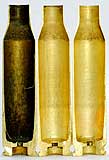 If you’ve read our feature story on Ultrasonic Cleaning by Jason Baney, you’ve seen the remarkable results that can be achieved with this method. Ultrasonic cleaning has many advantages over traditional tumbling methods of case cleaning. There is no dust or media residue to remove from the brass, and when done right, the cases come out clean and shiney, inside and out, even the primer pockets. If you’ve read our feature story on Ultrasonic Cleaning by Jason Baney, you’ve seen the remarkable results that can be achieved with this method. Ultrasonic cleaning has many advantages over traditional tumbling methods of case cleaning. There is no dust or media residue to remove from the brass, and when done right, the cases come out clean and shiney, inside and out, even the primer pockets.
In its Benchtalk Archives, Brownell’s has an excellent article discussing Ultrasonic Case Cleaning. Brownell’s staff compares results, with measured dwell times from 5 to 75 minutes, using both Mpro-7 and HCS 200 cleaning solutions. Tests are performed with once-fired and 5X-fired Tactical 20 (Tac20) cases, as well as once-fired .260 Rem Cases. The article also compares the results from ultrasonic cleaning vs. tumbling in walnut media. Below are Brownell’s results for Tac20 cases with the HCS 200 (non-acidic solution). Go to Brownell’s article for MPro7 results and Rem 260 results.
HCS 200 Cleaning Solution Test
Procedure — Solution was de-gassed for 15 minutes, then 63 Tac20 cases were placed in a single layer, in stainless steel mesh basket. The temperature of the starting solution was 102° F. When the cases were removed the temperature was 110° F.
Once-Fired Tactical Twenty Cases (HCS 200) — Observations
5 minutes: The exterior of the cases are not significantly brighter/cleaner. The primer pockets and case interiors are still dirty.
10 minutes: Exterior of the cases are brighter. 70% of the cases show some degree of cleaning of the primer pockets. Little difference seen inside the case, but case mouths are cleaner.
15 minutes: Case brightness is about the same. Still only 70% of the primer pockets are clean, but a larger portion of each is cleaner. A Q-tip swabbed inside the cases shows that carbon/powder residues are loosening up.
20 minutes: Case exteriors are brightening up. 80-85% of the primer pockets are about 90% clean. The insides of the cases and case mouths are cleaner.
25 minutes: Cases are brighter/cleaner than even new brass. 80-85% of the cases have almost completely clean primer pockets. The inside of the cases are 80-90% clean.
30 minutes: The insides of the cases and case mouths appear to be completely clean. 87% of the primer pockets are virtually 100% clean. 13% of the cases had stubborn primer pocket residue that could not be completely removed.
60 minutes: Eight cases (13%) were placed in the tank for another 30 minutes to try to remove the remaining residue in their primer pockets. Six out of the eight cases were completely clean.
Five-Times Fired Tac20 Cases — Observations
30 minutes: Based on the above observations, I didn’t begin to observe these 5-time fired cases until after 30 minutes: The exterior cases are bright/clean. Brighter than new cases. The primer pockets on 75% of the cases are 75% clean. The remaining cases had primer pockets that were only 25% clean. The inside of the cases appear to be clean.
65 minutes: 25% of the primer pockets were 95% clean, 25% of the primer pockets were 90% clean, 25% of the primer pockets were 85% clean; and 25% were 80% clean.
75 minutes: 75% of the primer pockets were 90% clean. |
How Does Ultrasonic Cleaning Work?
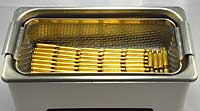 The Brownell’s article explains: “Ultrasonic cleaning uses high-frequency sound waves (generally between 20-80 kHz) to remove a variety of contaminants from objects immersed in a liquid. The result of these high-frequency sound waves is a process called cavitation. These high frequency bursts of ultrasonic energy produce a three-dimensional wave of alternating positive and negative pressure areas as the sound wave passes through the solution. During negative pressure, microscopic cavitation bubbles form and will continue to grown until they reach resonant size. As the positive sound wave passes, the pressure rises rapidly and implodes these tiny bubbles. Before these minuscule bubbles implode they store a tremendous amount of energy. These bubbles can be as hot as 10,000 degrees and have as much as 50,000 lbs per square inch of pressure. This sounds alarming, but you have to remember that these bubbles are microscopic in nature and pose no harm to anything, unless you are a carbon /powder residue deposit on a cartridge case! The Brownell’s article explains: “Ultrasonic cleaning uses high-frequency sound waves (generally between 20-80 kHz) to remove a variety of contaminants from objects immersed in a liquid. The result of these high-frequency sound waves is a process called cavitation. These high frequency bursts of ultrasonic energy produce a three-dimensional wave of alternating positive and negative pressure areas as the sound wave passes through the solution. During negative pressure, microscopic cavitation bubbles form and will continue to grown until they reach resonant size. As the positive sound wave passes, the pressure rises rapidly and implodes these tiny bubbles. Before these minuscule bubbles implode they store a tremendous amount of energy. These bubbles can be as hot as 10,000 degrees and have as much as 50,000 lbs per square inch of pressure. This sounds alarming, but you have to remember that these bubbles are microscopic in nature and pose no harm to anything, unless you are a carbon /powder residue deposit on a cartridge case!
 When this cavitation bubble implodes near your brass case, it transforms the bubble into a jet about 1/10th of its size. This jet of energy can travel as fast as 400 km/hour. At 43 kHz, as is the frequency for our L & R HCS 200 ultrasonic cleaner, this is happening 43,000 times per second. This micro-burst of extreme energy is responsible for removing contaminants from the surface of your cartridge brass. Ultrasonic cleaning can reach into crevices and inaccessible areas and remove surface debris that can’t be cleaned by any other process.” When this cavitation bubble implodes near your brass case, it transforms the bubble into a jet about 1/10th of its size. This jet of energy can travel as fast as 400 km/hour. At 43 kHz, as is the frequency for our L & R HCS 200 ultrasonic cleaner, this is happening 43,000 times per second. This micro-burst of extreme energy is responsible for removing contaminants from the surface of your cartridge brass. Ultrasonic cleaning can reach into crevices and inaccessible areas and remove surface debris that can’t be cleaned by any other process.”
Photos and quotes © 2007-2010, Brownells®, Inc. All Rights Reserved, Used with Permission.
Share the post "Ultrasonic Case Cleaning — What’s the Optimal Dwell Time?"
|



















 Norma is making a big push to expand its presence in the North American market. As part of this effort, Norma is introducing seven (7) new types of cartridge brass for 2014. We’re pleased to report that Norma-USA will be importing top-quality brass for the 6.5 Grendel, and 6.5 Creedmoor, two popular target cartridges. In addition, for 2014, Norma will offer 7mm RUM, 7mm Blaser Magnum, 300 AAC Blackout (300 BLK), .300 RUM, and the .338 Blaser Mag. The Norma brass we have shot in other chamberings (6 PPC, 6mmBR Norma, 6XC, .243, 7mm RSAUM) has all been excellent, giving good accuracy. Case weights were very consistent and the neck-wall thickness was very uniform, particularly with the PPC and BR brass. The new 300 BLK brass is an important offering for AR shooters. (NOTE: You can also make 300 BLK cases from Norma or Lapua .221 Fireball brass).
Norma is making a big push to expand its presence in the North American market. As part of this effort, Norma is introducing seven (7) new types of cartridge brass for 2014. We’re pleased to report that Norma-USA will be importing top-quality brass for the 6.5 Grendel, and 6.5 Creedmoor, two popular target cartridges. In addition, for 2014, Norma will offer 7mm RUM, 7mm Blaser Magnum, 300 AAC Blackout (300 BLK), .300 RUM, and the .338 Blaser Mag. The Norma brass we have shot in other chamberings (6 PPC, 6mmBR Norma, 6XC, .243, 7mm RSAUM) has all been excellent, giving good accuracy. Case weights were very consistent and the neck-wall thickness was very uniform, particularly with the PPC and BR brass. The new 300 BLK brass is an important offering for AR shooters. (NOTE: You can also make 300 BLK cases from Norma or Lapua .221 Fireball brass). On his
On his 






 When neck-turning cases, it’s a good idea to extend the cut slightly below the neck-shoulder junction. This helps keep neck tension more uniform after repeated firings, by preventing a build-up of brass where the neck meets the shoulder. One of our Forum members, Craig from Ireland, a self-declared “neck-turning novice”, was having some problems turning brass for his 20 Tactical cases. He was correctly attempting to continue the cut slightly past the neck-shoulder junction, but he was concerned that brass was being removed too far down the shoulder.
When neck-turning cases, it’s a good idea to extend the cut slightly below the neck-shoulder junction. This helps keep neck tension more uniform after repeated firings, by preventing a build-up of brass where the neck meets the shoulder. One of our Forum members, Craig from Ireland, a self-declared “neck-turning novice”, was having some problems turning brass for his 20 Tactical cases. He was correctly attempting to continue the cut slightly past the neck-shoulder junction, but he was concerned that brass was being removed too far down the shoulder.


 Hornady plans to start producing
Hornady plans to start producing 


 Bullets.com was launched as a result of the intense passion for shooting by its President, Shiraz Balolia. Shiraz has been shooting pistols, rifles and shotguns for almost 40 years and has been involved in long range rifle shooting at the National and International level for almost 10 years. He served as the Captain of the U.S. F-Class Open Rifle Team for the 2013 World Championship and was a member of the 4-man team that won the 2013 Nat’l 1,000-yard Championship. He has won numerous gold medals in long range shooting and has set several National records.
Bullets.com was launched as a result of the intense passion for shooting by its President, Shiraz Balolia. Shiraz has been shooting pistols, rifles and shotguns for almost 40 years and has been involved in long range rifle shooting at the National and International level for almost 10 years. He served as the Captain of the U.S. F-Class Open Rifle Team for the 2013 World Championship and was a member of the 4-man team that won the 2013 Nat’l 1,000-yard Championship. He has won numerous gold medals in long range shooting and has set several National records. In a world where too many companies have down-graded product quality and durability, we’re lucky there are some fanatical Finns who build great stuff for shooters. For serious handloaders, the cartridge brass of choice is made by
In a world where too many companies have down-graded product quality and durability, we’re lucky there are some fanatical Finns who build great stuff for shooters. For serious handloaders, the cartridge brass of choice is made by  If you’ve read our feature story on
If you’ve read our feature story on  The Brownell’s article explains: “Ultrasonic cleaning uses high-frequency sound waves (generally between 20-80 kHz) to remove a variety of contaminants from objects immersed in a liquid. The result of these high-frequency sound waves is a process called cavitation. These high frequency bursts of ultrasonic energy produce a three-dimensional wave of alternating positive and negative pressure areas as the sound wave passes through the solution. During negative pressure, microscopic cavitation bubbles form and will continue to grown until they reach resonant size. As the positive sound wave passes, the pressure rises rapidly and implodes these tiny bubbles. Before these minuscule bubbles implode they store a tremendous amount of energy. These bubbles can be as hot as 10,000 degrees and have as much as 50,000 lbs per square inch of pressure. This sounds alarming, but you have to remember that these bubbles are microscopic in nature and pose no harm to anything, unless you are a carbon /powder residue deposit on a cartridge case!
The Brownell’s article explains: “Ultrasonic cleaning uses high-frequency sound waves (generally between 20-80 kHz) to remove a variety of contaminants from objects immersed in a liquid. The result of these high-frequency sound waves is a process called cavitation. These high frequency bursts of ultrasonic energy produce a three-dimensional wave of alternating positive and negative pressure areas as the sound wave passes through the solution. During negative pressure, microscopic cavitation bubbles form and will continue to grown until they reach resonant size. As the positive sound wave passes, the pressure rises rapidly and implodes these tiny bubbles. Before these minuscule bubbles implode they store a tremendous amount of energy. These bubbles can be as hot as 10,000 degrees and have as much as 50,000 lbs per square inch of pressure. This sounds alarming, but you have to remember that these bubbles are microscopic in nature and pose no harm to anything, unless you are a carbon /powder residue deposit on a cartridge case! When this cavitation bubble implodes near your brass case, it transforms the bubble into a jet about 1/10th of its size. This jet of energy can travel as fast as 400 km/hour. At 43 kHz, as is the frequency for our L & R HCS 200 ultrasonic cleaner, this is happening 43,000 times per second. This micro-burst of extreme energy is responsible for removing contaminants from the surface of your cartridge brass. Ultrasonic cleaning can reach into crevices and inaccessible areas and remove surface debris that can’t be cleaned by any other process.”
When this cavitation bubble implodes near your brass case, it transforms the bubble into a jet about 1/10th of its size. This jet of energy can travel as fast as 400 km/hour. At 43 kHz, as is the frequency for our L & R HCS 200 ultrasonic cleaner, this is happening 43,000 times per second. This micro-burst of extreme energy is responsible for removing contaminants from the surface of your cartridge brass. Ultrasonic cleaning can reach into crevices and inaccessible areas and remove surface debris that can’t be cleaned by any other process.”




